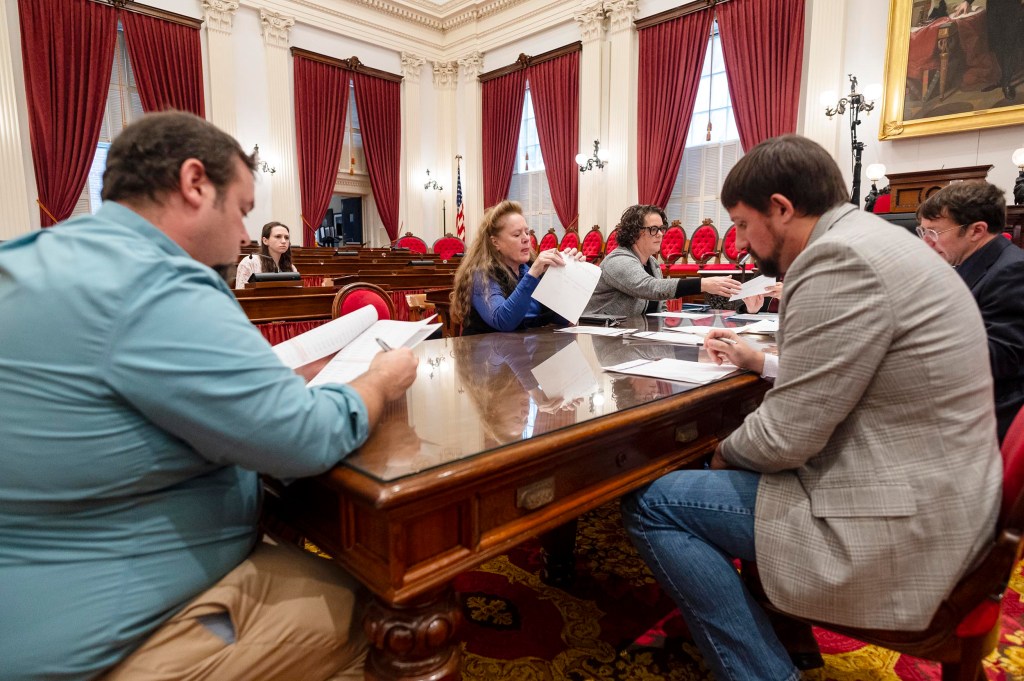

Vermonters turned out in record numbers to vote in this year’s general election, largely without a hitch, Secretary of State Sarah Copeland Hanzas said Tuesday at a formal event certifying the election results.
Out of 522,600 registered voters in the state, 372,885 cast their ballots in last week’s general election, Copeland Hanzas said. That’s nearly 2,000 more voters than the state saw in 2020 — a contest that shattered previous turnout records.
However, voter registrations are higher this year, resulting in a lower turnout rate for eligible voters than in 2020. This year, Vermont’s turnout rate was 71%, while in 2020 it was 73%.
“I am as pleased with the technical administration of this election as I could possibly be, but I’m even prouder of the participation levels,” Copeland Hanzas said. “This is what participatory democracy should look like.”
That was despite concerns the state’s election administration office had this year as it took note of threats and violence against voting processes in other states, and saw a noticeable rise in confrontational language against Vermont’s town clerks and election staffers.
“After hearing a smatter of vitriolic anecdotes in the weeks leading up to the election — from clerks, from election workers — Election Day, itself, went largely smoothly and respectfully,” Seán Sheehan, the office’s director of elections and campaign finance, said Tuesday.
Sheehan went on to say that, “fortunately,” Vermont did not see attacks on ballot drop boxes or bomb threats, both of which occurred in other states this year. But leading up to last Tuesday, he said local election officials reported that people had entered their offices “screamed, in some cases” about “voting by mail or other things they didn’t like about the election, or some of the disinformation that had been spread around the country.”
Asked if any offices received threats of physical violence, Sheehan said some communications were “borderline,” and the Secretary of State’s Office was in “close communication” with the Vermont State Police and FBI leading up to last week. The office also provided town clerks and election workers with de-escalation training.
But on Election Day itself, Sheehan recounted, “We didn’t hear many incidents at all. We really heard overwhelmingly that people were respectful. So we were very thankful to Vermonters for that.”
One week later, Copeland Hanzas and representatives of the state’s three major parties — Democrats, Republicans and Progressives — certified Vermont’s statewide election results. When they gathered in the Vermont House chamber to conduct the formality, security at the Statehouse was increased, including the use of a metal detector at the building’s entrance.
Among the races certified Tuesday was that for lieutenant governor, which saw Republican challenger John Rodgers outpacing Progressive Lt. Gov. David Zuckerman.
According to Tuesday’s canvassing report, Zuckerman received 165,876 votes to Rodgers’ 171,854 — a difference of just 5,978. But with neither candidate having secured more than 50% of the vote (Zuckerman received 44.5% to Rodgers’ 46.1%), the Vermont Constitution requires the Legislature to cast a final vote in January.
Zuckerman conceded the race last week but dangled the possibility that the Legislature could override voters — though leaders of the Democratic and Progressive parties threw cold water on the idea.
The certification of the lieutenant governor’s race, signed by Copeland Hanzas and the party chairs on Tuesday, made note that the Legislature would have the final word.
To Vermont Progressive Party Chair Josh Wronski, the outcome of that race highlighted why the party has long supported ranked-choice voting.
“We shouldn’t be punting decisions to the Legislature when you don’t have a majority support for any candidate,” Wronski told reporters after the canvassing process was complete. “We should just, through our ballot, get to a majority support through a ranked-choice voting process.”
Had ranked-choice voting been in place, Wronski hypothesized that Zuckerman would have clinched the election. He pointed to the 13,671 votes cast for Green Mountain Peace & Justice Party nominee Ian Diamondstone and said, “I can’t imagine that most of those folks would be voting for the Republican as their number two.”
But, Wronski clarified, “we have no way of knowing” whether that would be the case, and he said the Legislature should respect the popular vote and certify the election for Rodgers.
One down-ballot election mix-up, meanwhile, may still spur a revote in Bennington County. Late last week, the Secretary of State’s Office flagged a voter checklist error in the town of Pownal, which placed roughly 40 voters in the incorrect legislative district.
For the Bennington-1 House race, the results were close enough that those 40 or so voters who were incorrectly assigned to the Bennington-5 district could have made the difference: Democrat John Cooper prevailed over Republican Bruce Busa by just 25 votes.
“There were no other elections on either of those ballots that would have been close enough that those voters being placed in the wrong district could have made a difference,” Copeland Hanzas told reporters Tuesday.
Copeland Hanzas said she expected a challenge to the election outcome to be filed, and she said her office would recommend to the court that the court order a revote to be conducted by universal mail-in ballot.
Read the story on VTDigger here: A record number of Vermont voters cast ballots in last week’s election.


